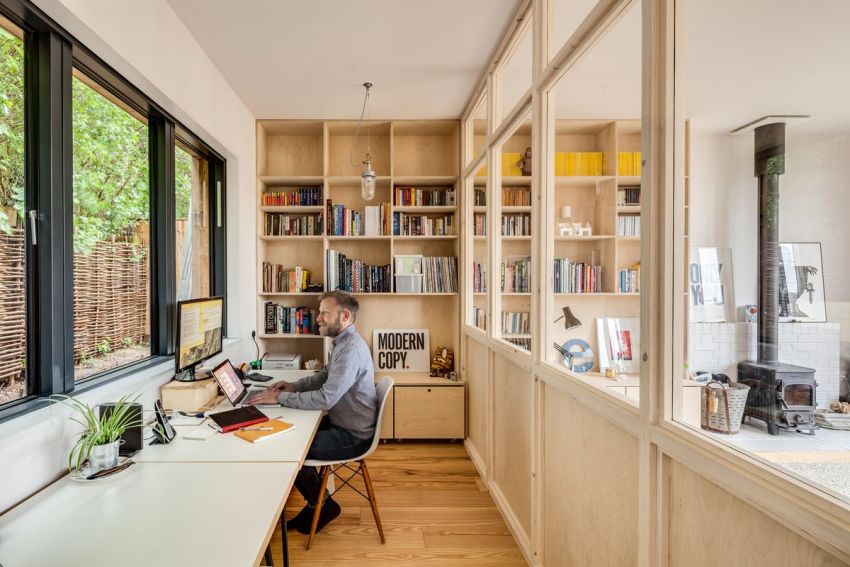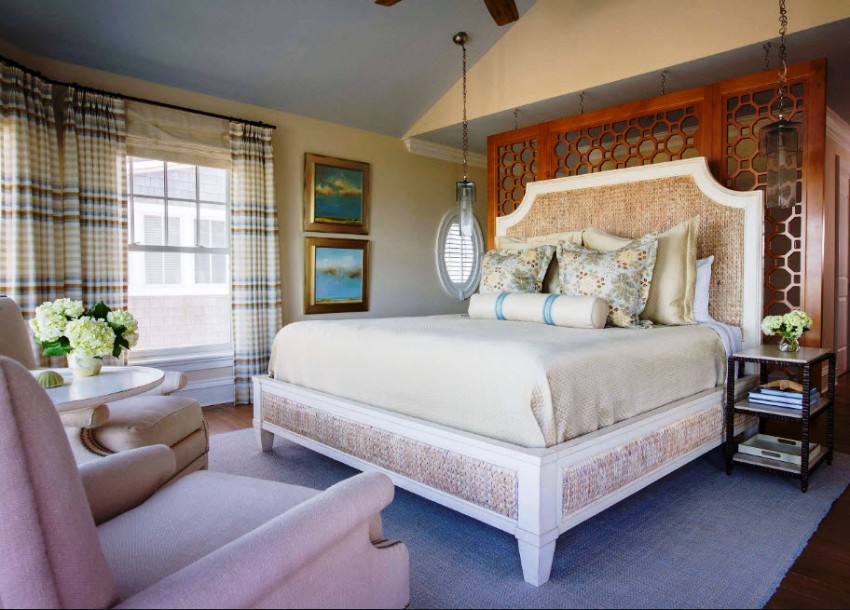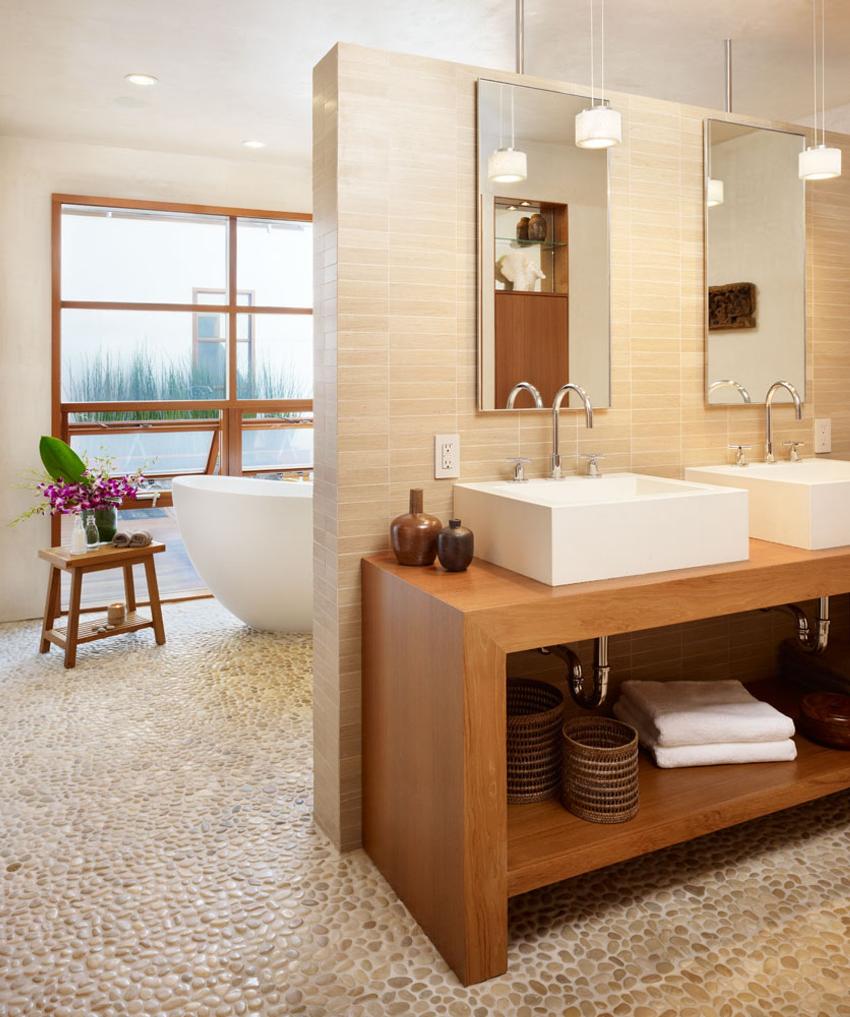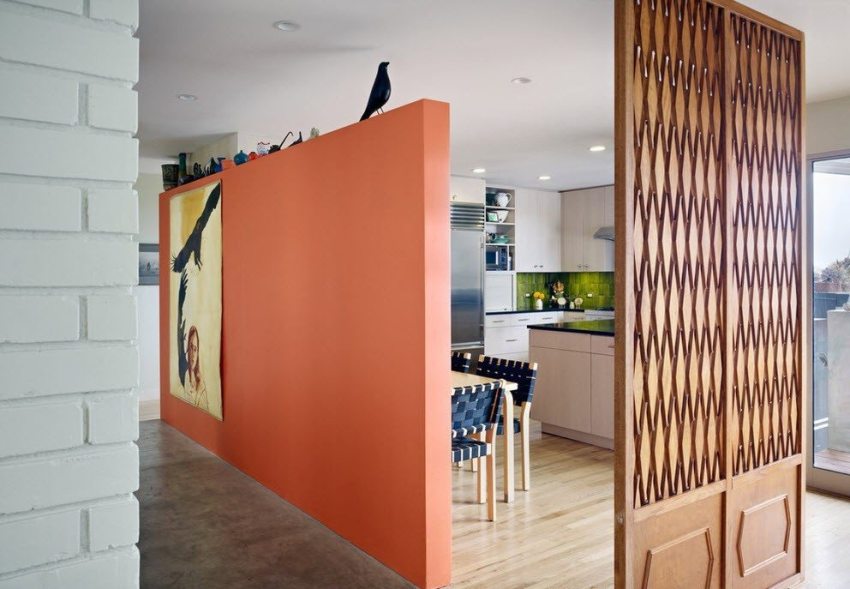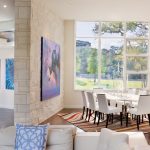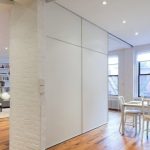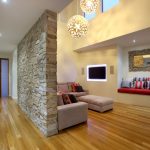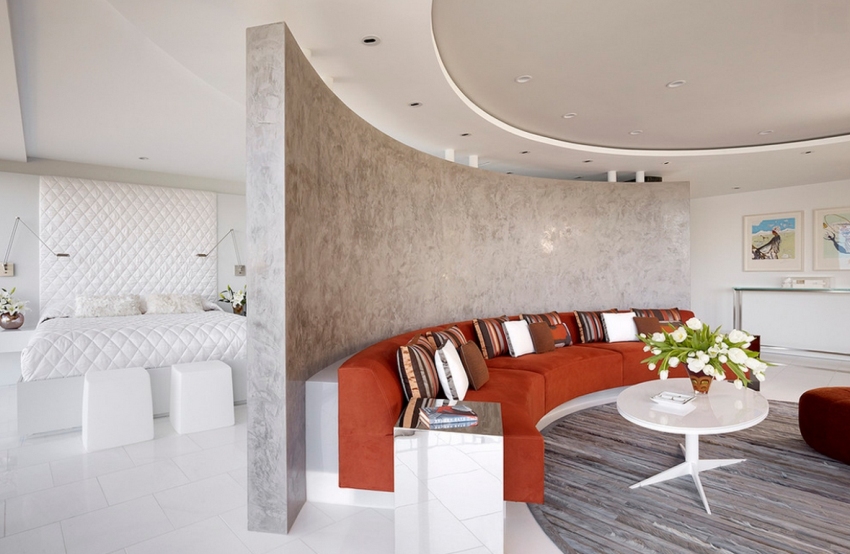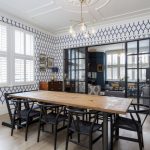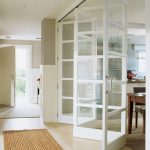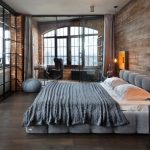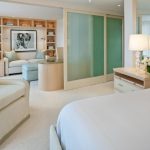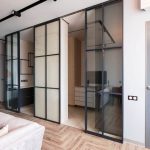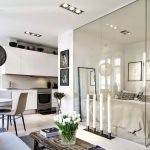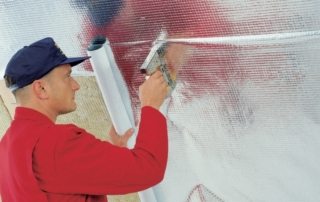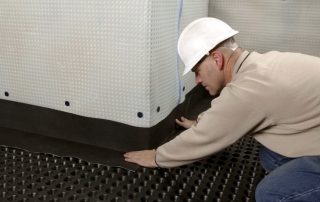Renowned architects and craftsmen use wood, aluminum and glass to organize the space, creating contemporary masterpieces. Thanks to talented designers, fashion trends and directions appear, and technical specialists develop new ways of processing material. If the creation of a brick or concrete interior partition requires special knowledge, then it is not difficult to build a wall with your own hands from plaster or foam block.
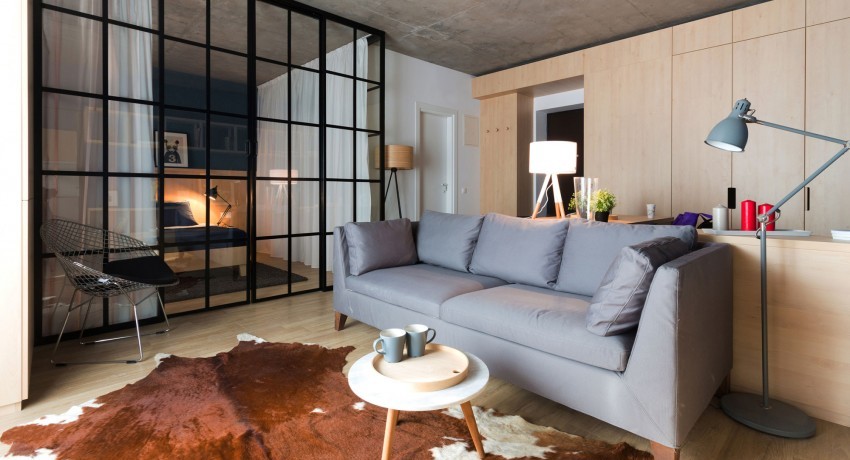
Interior partitions are an original way of organizing apartment space, combining a rich selection of decoration techniques and design solutions
Content [Hide]
- 1 Partitions made of wood: leading positions in the list of popular design solutions
- 2 The relevance of aluminum interior partitions
- 3 Dense and lightweight interior partitions made of foam blocks
- 4 Plasterboard partitions: the advantages of the tongue-and-groove installation principle
- 5 Brick partitions in an apartment: timeless traditions
- 6 Concrete partition wall: monumental practicality
- 7 Glass partitions for rooms: space and light magic
Partitions made of wood: leading positions in the list of popular design solutions
Interior partitions made of wood have been used for many years for zoning indoor space. They are made from different types of wood, but the following are considered the most common:
- Pine;
- ash;
- oak;
- beech.
Walnut veneer is often used for the manufacture of a partition, since its solid wood is almost never used for these purposes. Also, the actual material is the MDF profile, which is covered with veneer of almost any type of wood. Wood is attractive because it has a unique ring pattern: it is almost impossible to find the same natural ornaments. According to the principle of installing wooden interior partitions, stationary, sliding and mobile structures are distinguished.
The stationary version of the partition is attached to the walls, ceiling and floor. It is practically unlimited in size and weight, since the structure is fixed as much as possible. Sliding canvases are installed on special rails fixed to the floor and ceiling. Each sash of such a partition moves with the help of rollers along its own guide.
The interior partitions of the compartment are installed together with the parking area, in which the doors will be located at the moment the opening is opened.It is possible to implement such structures without using a parking zone, which allows you to expand the opening. Suspended installation systems are no less relevant. Their peculiarity lies in the fact that they move only along the upper rail, and at the bottom they are fastened with bolts.
Mobile wooden partitions are used most often as part of the interior. They not only perform the function of space zoning, but are also a design decoration of the room. Usually these structures look like a wooden screen, which can be placed anywhere and, if necessary, moved. Therefore, they have significant restrictions on weight and size, in contrast to stationary partitions in the house. Any competent designer and designer knows what to make a beautiful and functional screen.
Do-it-yourself wooden interior partition: well-known structural modifications
When decorating partitions indoors, glass is often inserted into a wooden frame. This makes the construction lighter and more comfortable. In this case, you can use transparent glass, you can matte it or choose various bright design options. It all depends on what function the partition will perform. Modern firms offer a large selection of various stationary structures, but sliding systems are limited in weight, they cannot be overloaded with massive glass.
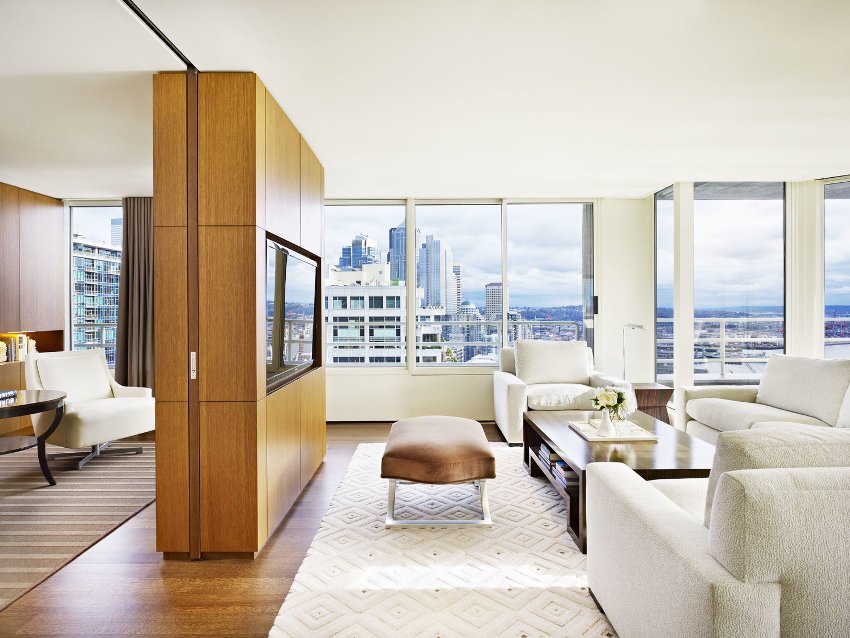
Most often, interior wooden shelving and partitions are used in large rooms and in rooms with a spacious layout.
Designers around the world are introducing new trends in space zoning into interiors. For example, it is very popular today to use old wood for creating new compositions and finishing structures.. Photos of partitions in the room, made of aged wood, can be easily found on the Internet. Taking up this idea, renowned designer Pete Hein Eyck launched a mass production of furniture and other interior elements from wood waste in Holland.
Note! Recycling is a complex work, as a result of which waste is given a second life.
A relatively new global technology is the use of burnt wood for decorative finishing. This effect is achieved by treating the material with a special solution. At the same time, the tree does not lose its qualities, it acquires new energy and a unique character. This trend is so practical that burnt wood is used not only for creating partitions and accessories, but also for decorating building facades.
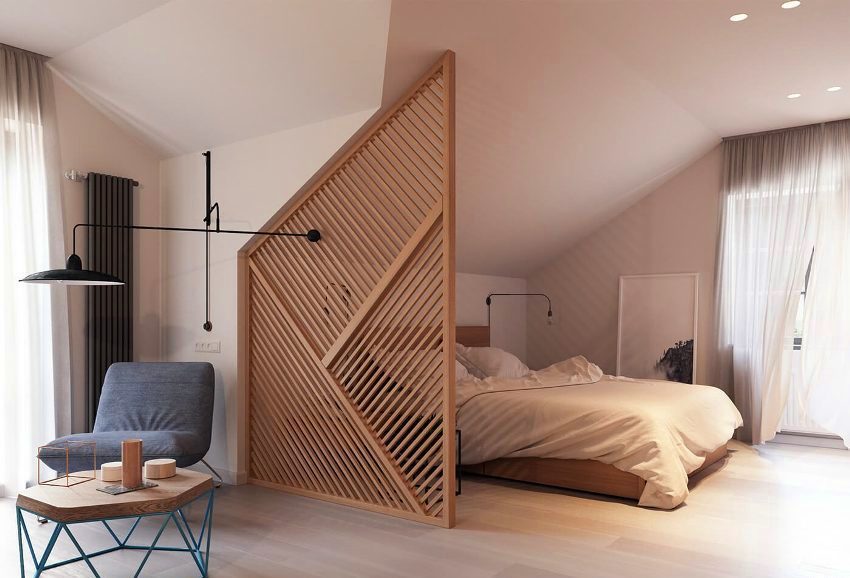
With the help of wooden structures, it is especially good to divide a room into sections that will perform various functions.
The Wabi-Sabi style is particularly sophisticated. This trend arose under the influence of Japanese culture. One of the famous admirers of this genre is the world-renowned designer Axel Vervoordt. Endless respect for the forces of nature, love of life characterize this style. The aesthetic system of Wabi presupposes strict asceticism. Therefore, the lines of such an interior are correct and clean. Particular attention is paid to textures. The wooden partition fits perfectly into the interior and contributes to the right mood. The price of such a design is definitely high.
The relevance of aluminum interior partitions
At the design stage, the question arises, what is the best way to make an interior partition. The main principle of aluminum products is the modularity of the design. For installation, an aluminum frame of the desired shape is used, which is attached to the walls, floor and ceiling. It is made by extrusion from an aluminum alloy. This material gains flexibility, corrosion resistance and lightness. At the same time, aluminum profiles are durable, they provide a sufficient level of safety.
The modules are filled mainly with light-transmitting material.Most often, glass is chosen for these purposes. This preference is due to the fact that today there is a large selection of glass on the market. It is decorated for any design project. They use chemical etching, special films, decorate with various elements, etc. Glass thickness usually ranges from 4 mm to 12 mm, which depends on the structure of the interior partition. What is the best way to make modules, experts will tell you.

The aluminum profile partition allows you to make the interior unique, original, rather cozy and multifunctional
According to the principle of installation and operation, stationary, sliding and mobile aluminum partitions are traditionally distinguished. As mentioned above, the frame of stationary structures is attached to the floor, ceiling and load-bearing floors. If we are talking about the construction of an interior partition, then doors are mounted in it. However, you can use this type of construction with an aluminum profile to zone the space inside the room. Then the partition, along with the delimitation of the area of the room, will perform a decorative function.
Sliding interior partitions are no less in demand. The price of aluminum structures is consistent with their quality. The most common types of sliding systems are:
- "Compartment" (or sliding partition);
- "book";
- "harmonic";
- suspended structure;
- transformable system.

According to the installation principle, stationary, sliding and mobile aluminum partitions are most often distinguished.
The main principle of the “coupe” system fastening is rail-track. Aluminum rails are installed on the floor and ceiling. The leaves are suspended using a mechanism with special rollers, so that they move along their guide. A parking zone for the leaves is formed, where they will be in the open position. Since aluminum alloy is a ductile material, it is possible to design a curved frame. In this way, you can create a radius partition.
"Book" and "accordion" are very similar systems. The partition consists of fragments of the canvas, which are attached to the upper rail, and at the bottom are held with a special pin. The blocks of these systems are connected by hinges, less often by springs. The "book" and "accordion" differ from each other only in the number of doors: in the first case, only two panels are connected. To install an accordion-type system, 3 or more elements are used.
For suspended aluminum structures, the plates are only attached to the ceiling top track. This allows you not to spoil the floor covering during installation. The doors of the interior partition move with the help of a roller mechanism, and are connected with hinges. The transformable system does not imply fastening the panels to each other, they move separately from each other.
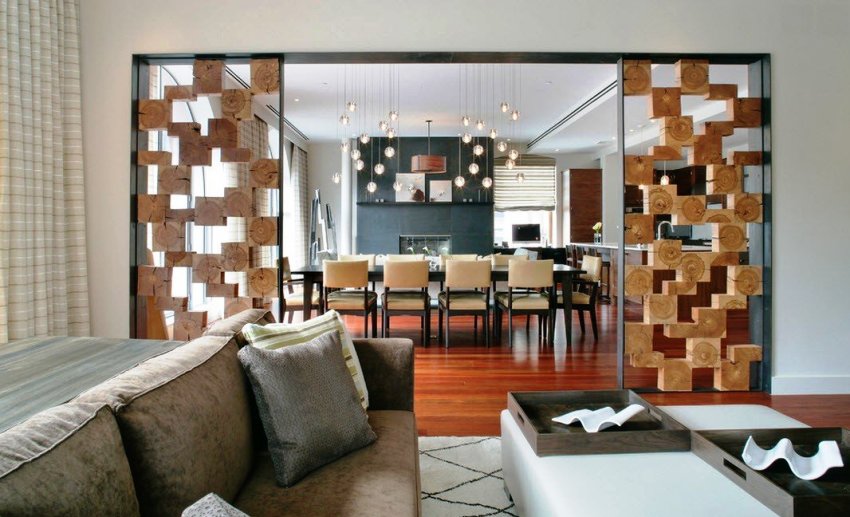
Interior structures with an aluminum profile are successfully used for zoning the space inside the room
Dense and lightweight interior partitions made of foam blocks
The foam block is a unit of modern and practical material for creating partitions. It has won a place in the building materials market due to its technical characteristics. Despite its large size, the foam block is light in weight. This greatly facilitates its transportation and installation of structures. The material lends itself well to sawing, drilling, and other processing. An additional advantage is the price of interior partitions made of foam blocks.
Due to the special texture, the foam block can be finished using any decorative methods: gluing wallpaper, plastering, laying tiles, etc. It is resistant to the influence of the environment: temperature drops, humidity, microorganisms are not afraid of it. Also, this material perfectly retains heat and has a high level of sound insulation.Interior partitions can have any shape, as the foam block is perfectly sawn and is suitable for the embodiment of creative design projects.
It is important to choose the right material for the future construction. Foam blocks are made using an autoclave. This method makes the segments strong and provides uniform porosity. The non-autoclave method is also used, but experts do not advise purchasing products made in this way due to its low technical performance.
Important! An autoclave is a special chamber where the material acquires its properties due to heating under high pressure.
In the manufacture of finished blocks, manufacturers use special forms into which liquid foam concrete is poured. The shaping method is quite simple, but the segments are not ideal, so difficulties may arise during laying. The option of preparing foam blocks using a circular saw is considered more suitable. Thus, ideally even fragments of the future structure are produced.
The dimensions of the foam blocks depend on the thickness of the interior partition, its height. In addition, it is necessary to take into account what functions this structure will perform. Most often, fragments of the standard size 30x60 cm, 10 cm thick and D600 density are used. This is the optimal ratio for a partition in the house. For the outer walls, a denser foam concrete is required.

Partition made of pino blocks finished with tiles perfectly retains heat and has a high level of sound insulation
Plasterboard partitions: advantages of the tongue-and-groove installation principle
Indeed, gypsum and alabaster are similar in composition. But there are key differences in their production technology. It is thanks to the special manufacturing method that the moisture resistance of the material increases, the weight of the structure decreases, and an excellent soundproofing effect is also achieved. This material contains gypsum chips and mineral additives.
Related article:
Glass partition in the interior: elegance and lightness of transparent structures
Examples of using. Zoning of studio apartments. Expansion of space, filling the room with light.
By structure, there are 2 types of gypsum slabs: hollow (hollow inside) and monolithic (solid). Hollow blocks are produced with a thickness of 8 and 10 cm; they have excellent sound insulation properties precisely due to the presence of voids inside the slab. Monolithic blocks are characterized by high strength, they are produced on average 4 cm thick (one slab).
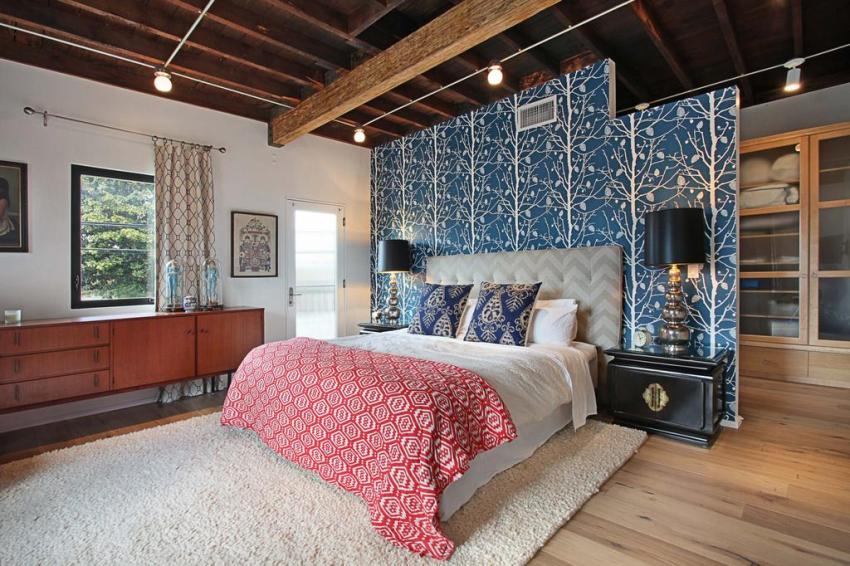
According to the structure, two types of gypsum boards are distinguished: hollow (hollow inside) and monolithic (solid)
Before starting work, you need to select the appropriate blocks. Experts advise using moisture resistant plaster. This will increase the service life, since such plates are not susceptible to mold and mildew. Since this material is non-flammable, a dedicated wiring duct can be dispensed with during installation. Installation of interior plaster partitions does not cause any particular difficulties.
Note! Experts advise to leave gypsum boards for several hours in the room in which they will be installed. During this time, the material adapts well to temperature and humidity.
Plates, thanks to the tongue-and-groove principle, can be installed without experience and special knowledge in this area. Hollow core products are suitable if it is not recommended to overload the floor in the room. Due to the internal emptiness, they have less weight. Also, due to the peculiarities of the structure, they provide a higher level of noise insulation of interior partitions. For maximum styling effect, soundproofing tape can be used. Despite the fact that the material is very durable, it is easy to saw and chase.
To strengthen the structure of the partition, a reinforced mesh should be used. The interior wall will turn out to be even more durable, and will also perfectly retain heat. If materials are combined during installation, it is recommended to use a damper tape. Due to it, it will be possible to reduce the shrinkage difference when using materials, for example, when combining plaster and wood.
Brick partitions in an apartment: timeless traditions
For a long time, brick is considered one of the most reliable materials for laying interior walls. What is the best way to build a partition, the architect will tell you. However, any shelves and other necessary decorative elements can be attached to a brick wall. This is far from the only advantage of brickwork. Such a wall has a high level of sound insulation, which creates the most comfortable living conditions.
Since this material has a significant weight, in apartments they lay a wall in half or a quarter of a brick. The thickness of the interior brick walls ranges from 12 to 15 cm, the weight of the structure is approximately 280 kg / m². The size of a wall of standard thickness with putty is about 27-28 cm. The weight of such a partition will be several times greater and, accordingly, there will be an unacceptable load on the supporting structures.
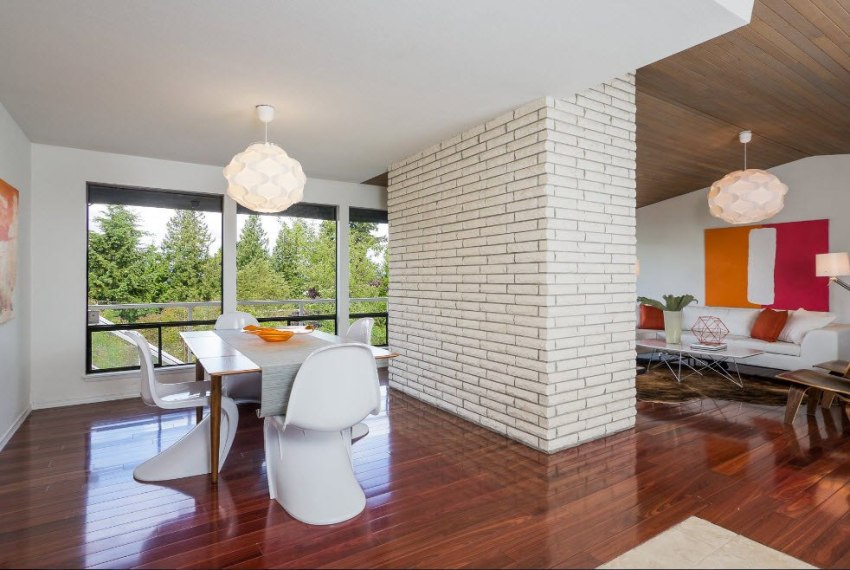
Since the brick has a significant weight, in apartments they put a wall in half or a quarter of a brick
The construction of brick partitions requires basic knowledge in this area. Failure to comply with the requirements can lead to the fact that the wall will lead. Particular attention is paid to the markings and the first row. First, a layer of waterproofing agent must be applied to prevent vibration. Basically, builders use roofing material for these purposes.
Details and subtleties of installing interior partitions made of brick
Interlayer mortar is a very important structural element. Its consistency should not be watery, so that the joints are not squeezed out between the bricks. In this case, it is necessary that the mixture be sufficiently plastic - in this case, it will be easier to work with the seams. The most optimal joint thickness is 1-1.2 cm. Experts advise not to distribute the mortar over the entire area of the brick, since later the wall will need to be plastered. This method is called "wasteland".
Do not build a wall higher than 150 cm at a time. This is due to the fact that the masonry needs to grab and get stronger, otherwise the wall can lead. Brick walls are strengthened using reinforced rods with a diameter of 0.4-0.6 cm. They are laid along the entire length every 4 rows of the partition. A gap is left under the ceiling (about 2-3 cm), it is laid with felt and plastered.
During installation, craftsmen must tie up the seams. In the case of half brick masonry, only vertical dressing is used. It is necessary to lay bricks in such a way that the vertical seam between the fragments of the masonry is located in the center of the brick under it, in the previous row. To do this, the rows begin with a whole brick, then with a half. This ensures structural integrity and compliance with all building standards.
Useful advice! For convenience, you can "soak" the bricks in water. In this case, they absorb water from the joint solution more slowly and are easier to fit.
The so-called "moorings" help to create a smooth wall. These are stretched cords that allow the master to navigate the masonry and avoid the bulge of the pier. These ropes are pulled along the wall to lay the row at the correct distance each time. This method will allow you to avoid an unpleasant situation when a "belly" appears at the wall, that is, the masonry moves with each row more and more to the side. Subsequently, the structure will have to be destroyed and rebuilt.
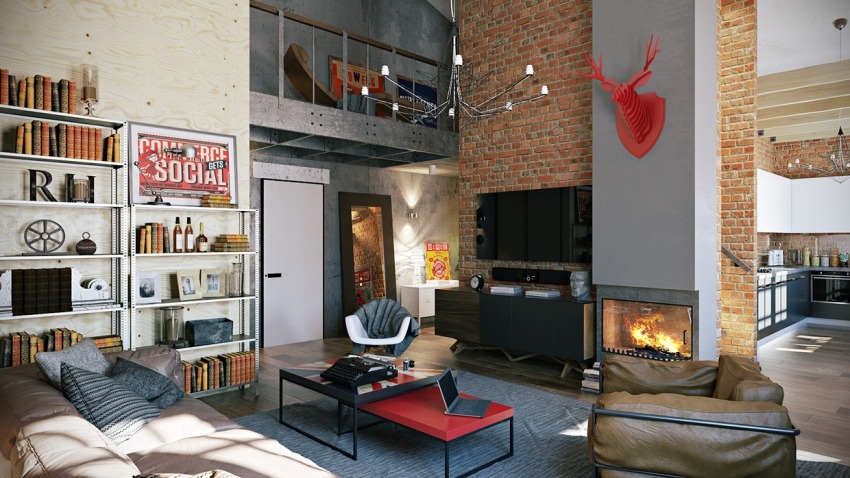
The brick interior partition is quite durable, so any shelves and other necessary decorative elements can be attached to it
Concrete partition wall: monumental practicality
On the Internet, you can find a lot of information about what to make a partition in an apartment from. Aerated concrete is not a novelty on the building materials market. It is produced by foaming a cement solution. At the exit, concrete blocks of a standard size 20x25 cm and a height of 6 cm are obtained. For the construction of an interior partition, material with a density of D500, D600 is suitable. One of its advantages is its relatively low weight. In addition, aerated concrete has excellent fire resistance.
Due to the fact that there is air inside the segments, cellular concrete perfectly retains heat. It has a good thermal conductivity of 0.14 W / m² ° C. It should be noted that the air permeability of such a partition is a negative characteristic of this material. However, the concrete wall, due to its structure, has good soundproofing properties. Depending on the thickness, this indicator ranges from 37 dB to 57 dB.
The technology used when laying aerated concrete is the same as when erecting a brick partition. The same techniques are used with moorings, blocks are laid by tying the seams. The structure is reinforced with reinforcement rods, and you can also fix the wall to the floor covering with metal profiles. For the joints, use simple tile glue or cement mortar with sand.
Glass partitions for rooms: space and light magic
Rapidly developing production makes the material more durable and safer. To create practical partitions in the interior, tempered glass with a thickness of 1-1.2 cm is used. Thanks to a special processing using high temperatures in special ovens, this glass acquires all its special properties. Its decisive difference from the "raw" one is that the fragments of the tempered and annealed sheet are not traumatic - they are rather fragments of broken glass with rounded edges.
Note! Due to its strength, triplex is used for glazing vehicles, aircraft, railway rolling stock and armored vehicles.
It is in no way inferior to the tempered type of triplex glass. This material is produced by gluing three layers of glass with a special polymer. Polyvinyl butyral is most often used as an interlayer. At the same time, the sheet does not lose its throughput, and also withstands loads of approximately 200-300 kg / m². Today, you can find such types of triplex as shockproof, fireproof, bulletproof, soundproof, etc.
Organic glass is considered no less popular. Acrylic and decoracryl are a new trend in the field of interior decoration and zoning. Due to the special properties of this material, any decorative interior partition can be easily made. Over time, experts have learned to fuse decorative ornaments into the structure of plexiglass. Acrylic sheets can be mounted either on a frame or without it. Acrylic glass sliding systems are widespread.
Depending on the project and the location of the partition, the glass can be made frosted. Thus, it becomes possible to close the space from prying eyes, create a secluded part of the room, and limit personal space. This technique is often used in the construction of office cabinets and the construction of partitions in a studio apartment. Matt is applied using a special film, chemical etching or sandblasting. You can combine transparency and opacity of glass using this technique to create ornaments or designs.
There are sliding glass room partition systems (as is the case with wood and aluminum partitions). The leaves move along the rails using a roller structure. At the same time, the “coupe” system is fixed from below and from above, while the suspension version is only from above. It is possible to design a parking area for blocks (this is not a requirement).
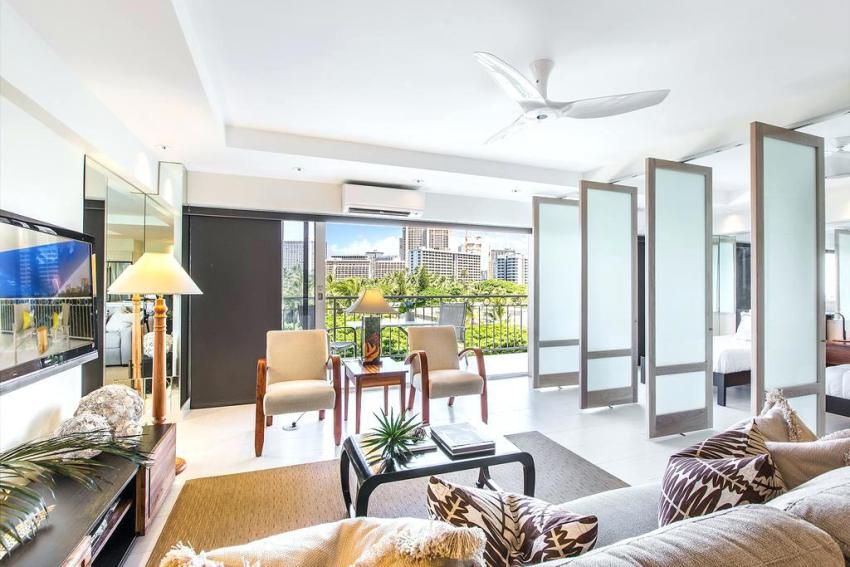
Interior glass partitions provide good protection against noise, provide thermal insulation and meet fire safety requirements
An unusual atmosphere in the house is created by light bulbs installed on glass interior partitions. Photos of this design convey only part of the emotions from the fabulous setting of the room. In the office sector, the smart glass technology brings a fantastic touch. This is an electrochromic glass that allows you to control light levels when exposed to electricity.
Having learned in detail about what to make interior partitions from, you can proceed to action. Competent design and professional approach are able to organize the space in the best way!
